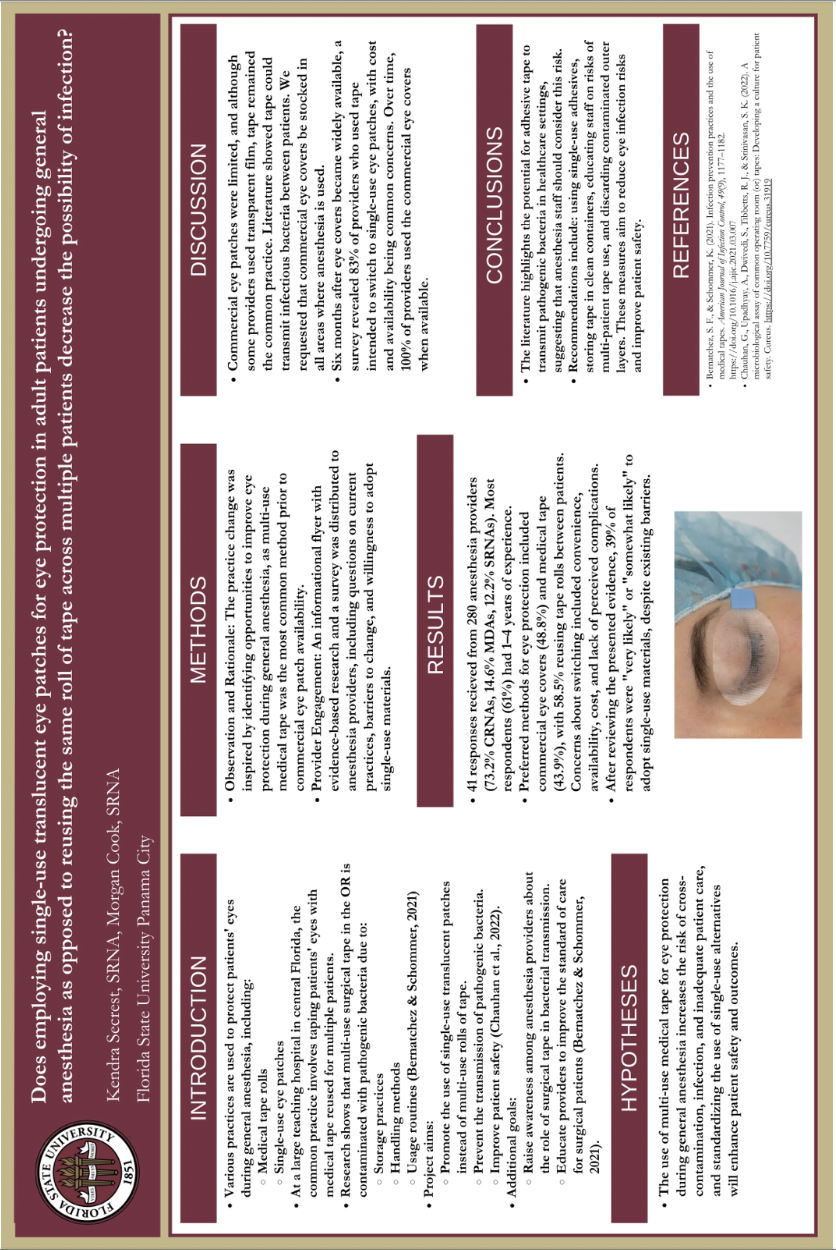Student Research Symposium Program Portal: Submission #57
Submission information
Submission Number: 57
Submission ID: 7811
Submission UUID: 3e1e9200-ef0a-4b4a-aa70-8957423f88c5
Submission URI: /student-research/symposium/research-symposium-program-portal
Submission Update: /student-research/symposium/research-symposium-program-portal?token=m7XMu7b3yAmrAzl0Ae9RiBFwUeh3JrdwRoz18AhOzIQ
Created: Wed, 02/05/2025 - 10:27 AM
Completed: Wed, 02/05/2025 - 10:49 AM
Changed: Tue, 04/01/2025 - 08:40 AM
Remote IP address: 142.197.114.198
Submitted by: Anonymous
Language: English
Is draft: No
Webform: Research Symposium Program Portal WF
Submitted to: Student Research Symposium Program Portal
Kendra
Secrest
{Empty}

Doctor of Nurse Anesthesia Practice
Before pursing her degree in Nurse Anesthesia, Kendra spent most of her 5 years as a nurse working in the cardiothoracic intensive care unit. In school, she continues to have a strong passion for caring for cardiac surgical patients and hopes to provide cardiac anesthesia after graduation. Research interests include ways to optimize patient care through improving the quality and effectiveness of healthcare delivery.
Does employing single-use translucent eye patches for eye protection in adult patients undergoing general anesthesia as opposed to reusing the same roll of tape across multiple patients decrease the possibility of infection?
During general anesthesia, the patient's eyes must be protected to prevent corneal abrasions (Grixti et al., 2013). Several approaches are used to ensure that the eyelids remain closed during surgery including medical tape, transparent film, and single-use eye covers. There is no standard of care that delineates the superiority of one method of protection over another, as long as the eyelids remain closed, and the eyes are protected from external insult. Prior to the implementation of this project, the most commonly used method of eye protection at a large teaching hospital in central Florida was medical tape, likely due to its low cost, ease of use, and widespread availability throughout the hospital. Multi-use medical tape, however, carries an increased risk of healthcare acquired infections owing to the fact that it is almost never washed or sterilized after opening, is exposed to many patients and clinicians, and it is used to secure invasive lines, drains, and airways, and wound dressings.
The purpose of this paper is to highlight medical tape’s role in microbial transmission and to advocate for a simple practice change among anesthesia providers that reduces risk and promotes improved hygiene for patients. The following PICO question was used to search literature databases and guide the process improvement project: Does employing single-use translucent eye patches (I) for eye protection in adult patients undergoing general anesthesia (P) as opposed to reusing the same roll of tape (C) across multiple patients decrease the possibility of infection (O)?
The purpose of this paper is to highlight medical tape’s role in microbial transmission and to advocate for a simple practice change among anesthesia providers that reduces risk and promotes improved hygiene for patients. The following PICO question was used to search literature databases and guide the process improvement project: Does employing single-use translucent eye patches (I) for eye protection in adult patients undergoing general anesthesia (P) as opposed to reusing the same roll of tape (C) across multiple patients decrease the possibility of infection (O)?
Gerard Hogan
Florida State University
Nurse Anesthesia
ghogan@pc.fsu.edu
Stacey VanDyke, Scott Stewart
Morgan Cook
“eye protection under general anesthesia” and “medical tape and bacterial transmission”
https://pc.fsu.edu/student-research/symposium/symposium-program-2025/dnap
Complete
Synchronous Online Presentation
CookSecrestPoster_0.pdf1.45 MB

No
2025
5th annual Undergraduate Research Symposium, April 17, 2025
https://pc.fsu.edu/student-research/symposium/research-symposium-program-portal?element_parents=elements/student_photo&ajax_form=1&_wrapper_format=drupal_ajax&token=m7XMu7b3yAmrAzl0Ae9RiBFwUeh3JrdwRoz18AhOzIQ
{Empty}

